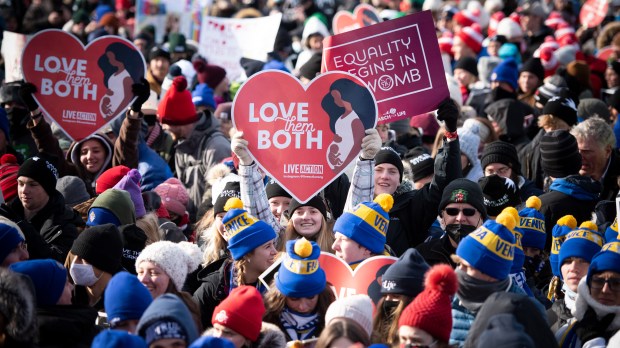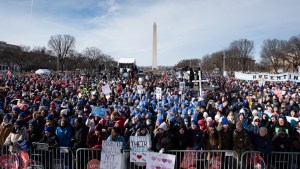The optimism in the air at this year’s March for Life was palpable.
In fact, the mood bordered on the jubilant, as a sea of mostly young people marched down Constitution Avenue to the Supreme Court to protest, possibly for the last time, Roe v Wade, the 1973 landmark decision that legalized abortion nationwide.
Bearing signs proclaiming, “We Are the Post-Roe Generation,” “The Future is Anti-Abortion,” and “After Roe, There is Life,” tens of thousands of high school and college students who arrived in Washington by the busload, cheerfully endured a bitterly cold day to march for the cause of the unborn for perhaps the last time. After 49 years in which abortion on demand has been the law of the land, Roe could soon be reversed when the Court issues its decision on Dobbs v. Jackson Women’s Health Organization.
And then something unusual happened.
After decades in which the story of the March for Life was hardly covered at all, attention was paid.The media took notice.
New York Times: “A Movement Energized”
On the day after the march —on the 49th anniversary of the Roe v. Wade decision— the New York Times ran an above-the-fold, extra-large photo from the March for Life. Stretching across four newspaper columns was a picture of a crowd of beaming young faces gathered on the National Mall.
The caption read “A Movement Energized. Indications the Supreme Court could overturn Roe v. Wade gave the March for Life rally in Washington a celebratory turn.”
The predominance of young people wasn’t lost on the New York Times reporter who interviewed a couple of older veterans of the march:
Doug Winne, 69, and Ruth Winne, 65, had driven two hours from Lancaster, Pa., to this year’s rally. They have attended the March for Life regularly for about 35 years, and Mr. Winne said he was encouraged by the number of younger people in attendance.
Gazing at the crowd around him, Mr. Winne said he was hopeful that younger people would continue to fight to end abortion. “We’re clearly on the older end,” Mr. Winne said. “That’s an encouragement that this isn’t just something that we, as people in their 60s, are concerned about.”
Young people are trending pro-life
A look at the age of the crowd at the march might lead one to believe that young people are more pro-life that one might have imagined. Recent polling data seems to back this up.
According to a new poll commissioned by Students for Life of America, a majority (52%) of young Americans support banning abortion after a fetal heartbeat is detected.
More from the mainstream media
Here are a few more examples of times the media sat up and took notice of new “The Post-Roe Generation:
“Still, the rally drew a crowd of thousands, with a heavy contingent of young people and students bussed in by schools and church groups. The mood was overwhelmingly upbeat, with many treating the end of Roe v. Wade as inevitable.”
“As usual, the crowd at the March for Life skewed young, with many students from Catholic high schools and colleges wearing their school gear and carrying signs and banners with antiabortion slogans.”
Who got the story wrong
Not every mainstream news outlet covered the March for Life, and some seemed to willfully ignore the overwhelming majority of young people at the march.
NBC News ran a story by an abortion advocate
that (strangely) described the March for Life as “an annual gathering on the National Mall featuring anti-abortion rights leaders and schoolchildren bused in from across the country.”
A look at any of the photos or video from the day should make clear that these were not “schoolchildren” being dragged to a demonstration. What’s worse, though, is the article’s attempt to link the agenda of political extremists with the pro-life advocates in attendance.
The article, written by Renee Bracey Sherman, founder of Abortion Access Front, reported that white nationalist groups attended the march, and struggled to associate them with pro-lifers.
“It’s clear that plenty of the March for Life’s attendees are at least open to listening to these white nationalist groups’ ideas. The intersection of white supremacists and anti-abortion rights ideology isn’t new — in fact, abortion restrictions have often been tied to increasing anxiety among white nationalists,” Sherman wrote.
Whatever the media reports, whether Roe v Wade is reversed or not will be decided by the Supreme Court. If it is reversed, the fight for the unborn won’t, of course, be over, and the pro-life movement will need its youngest advocates to lead the way as the battle over life returns to the states.


